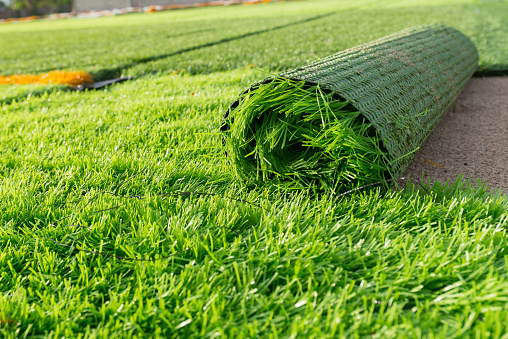We Need to Rethink Artificial Turf’s “Environmentally Friendly” Label, Here’s Why

Artificial turf may not require consistent watering, but the harms it causes for the environment are far worse than any benefits.
Artificial turf is a current landscaping trend. The topic of replacing natural grass with plastic coated blades has become a hot topic in many communities, especially those plagued by drought. For example, my city considers artificial turf a part of their climate action plan, citing the water conservation it would entail as an environmental benefit. Across cities, artificial turf can be found, from school fields to backyards and local parks. When asked why people are moving away from natural grass to plastic blades, they state that artificial turf is convenient, easy to manage, and good for the environment since it reduces the amount of water used.
To call artificial turf environmentally friendly is a misnomer. While it is true that artificial turf does not require consistent watering, the environmental and health harms that it does cause far outweigh the benefits artificial turf could potentially bring. Considering the bigger picture, adopting artificial turf is not a transition that our planet can afford to make. Synthetic turf is a threat to public health and our environment.
Synthetic turf overheats, killing the living biome beneath and adding a multitude of carcinogenic chemicals to our Earth. Last June, UC Davis had to cancel their commencement speech. Amidst the summer heatwaves and the dangerously overheating synthetic turf attendees stood on, multiple students passed out. There were 36 heat-related medical calls to the hospital, and seven people had to be hospitalized. Additionally, the toxic runoff from artificial turf when it overheats will only increase the contamination of our planet’s water.
PFAs, also known as “forever chemicals,” are the chemicals used to coat each blade of plastic grass. Their effects are far from harmless. According to an article published by the Guardian, a new analysis has shown that the PFA industry is the second largest polluter of HCFC-22. HCFC-22 is a greenhouse gas that has been banned internationally through the Montreal Protocol due to the danger it poses to the ozone layer. Additionally, PFAs are toxic to humans and produce adverse health effects. According to an article published by EarthJustice, multiple studies have linked PFAs to high cholesterol, cancer, and contaminated water sources. PFAS can be absorbed through many means of contact through the skin, ingestion, or inhalation. Young children are especially vulnerable due to their smaller size. Plastic grass also contains microplastics, and when the fake grass in fields, lawns, or parks begin to break apart, any surrounding soil and waterways get contaminated. This is because the plastic containing microplastics releases microplastics as it deteriorates.
In the long run, plastic grass destroys the environment instead of protecting it. Not only does plastic turf require huge amounts of plastic that our environment can’t handle, it also presents pressing health issues due to its toxicity. To put the dangers of artificial turf in perspective, the health effects of plastic turf are so severe that cities around the world have taken action against it. Boston and Millbrae are two examples, with Boston instating a ban and Milbrae placing a moratorium on plastic grass several years ago. Additionally, the California bill SB 499, also known as the School Extreme Heat Action Plan Act of 2023, was introduced this February. If passed, the bill would phase out synthetic turf in public school sites and replace it with less heat absorbing substances.
Our communities should not have to worry about being exposed to health hazards. Though it may seem promising, artificial turf is not a safe, friendly alternative to natural grass. We have to stop categorizing or regarding artificial turf as environmentally friendly. To do so creates dangerous implications for the future of our cities as they move towards adopting sustainable measures. Artificial turf is not part of the plan for an environmentally sustainable future, and we need to recognize this fact.

Glen Steinle • May 8, 2023 at 4:01 pm
Wow, this is an eye-opening article! Do you recommend sticking with plants instead of synthetic substances, and if so, are there alternatives to grass that are less water-hungry?